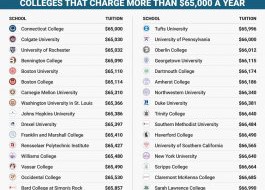
American undergraduates are relying less on student loans these days to fund their postsecondary education, but that does not mean their degrees are becoming more affordable.
Two reports released Wednesday by The College Board, a nonprofit that aims to expand access to higher education, show that education borrowing declined for the fifth consecutive year, even as a slowing rise in tuition and fees continues to drive net costs higher.
While reliance on loans fell to a two-decade low during the 2015-2016 academic year, grant funding for undergraduates rose to a two-decade high. But the rise in grant funding has been insufficient to cover the rise in net costs, leaving students and their families to make up the difference. Since tuition and fees continue to outpace household incomes and prices of goods and services as well, economic factors dramatically influence decisions about what and where to study.
"I've always had a job, and I've always been pretty solid at keeping money, but I also know that the world is changing every day, and student loan debt is a bigger issue than a lot of other national debts, like credit card debt," Alison Betts, a freshman hospitality and tourism management major at Palm Beach State College in Lake Worth, Fla., tells The Christian Science Monitor. "I'm afraid that I'm not going to land a solid job as soon as I would like, and I'm going to be in debt longer than I would like."
While experts say the latest numbers are no cause for alarm, the reports come as politicians have pushed for reforms that aim to make a college degree more easily attainable, even for low- and middle-income Americans. Presidential nominee Hillary Clinton – influenced by her main opponent in the Democratic primaries, Sen. Bernie Sanders (I) of Vermont – has proposed makingfour-year public colleges and universities tuition-freefor students whose families earn less than $85,000 per year.
Republican nominee Donald Trump has said he would cap student loan repayment at12.5 percent of a borrower's income, with forgiveness of any remaining balance after 15 years of successful payments. Additionally, Mr. Trump said he would lower college costs by loosening federal restrictions on universities.
 Hillary Clinton and Bernie Sanders. Justin Sullivan/Getty Images
Hillary Clinton and Bernie Sanders. Justin Sullivan/Getty Images
As the recession of 2007-2009 sent the unemployment rate as high as 10 percent in the United States, student borrowing and tuition both rose sharply as well. As the economy has recovered, borrowing rates have steadily fallen, a long-term trend reflected in the latest College Board reports.
"There's no dramatic change this year," said Sandy Baum, a senior fellow at the Urban Institute and a coauthor on the reports, Inside Higher Ed reported. "Borrowing is continuing to decline per undergraduate student. Sticker prices are continuing to increase, but not at a really rapid rate."
While those long-term trends might paint a big picture that is not nearly as dire as some warn, Ms. Betts says she sometimes doubts whether she will be able to afford the four-year degree she just began pursuing.
"I question that all the time, actually," Betts says. "I guess I never really learned that much about the financial aspect behind college and school."
Betts minimizes her expenses by living with family members, instead of lodging in a dorm or apartment of her own. And instead of a private institution that some might deem more prestigious, the Indiana native decided to attend Florida's Palm Beach State College, a public school, where Mrs. Clinton spoke Wednesday and mentioned her college tuition plan, as The Sun Sentinel reported.
Despite her frugality, Betts still fears her student debt could swell to $40,000 by the time she graduates, even with a partial scholarship and even if she does not transfer to a private school. That level of debt would place her in the company of the 10 percent of undergraduate borrowers who owed $40,000 or more in 2015, according to the College Board reports. A much larger share, 38 percent, owed $10,000 or less.

Cameron Canete, a sophomore studying political science at Arizona State University, says financial considerations played a major factor in his decision to stay in Arizona instead of attending a school in California with a strong program and perhaps better opportunities for political science majors.
"If they were less expensive, I probably would have gone there," Mr. Canete tells the Monitor. Thanks to in-state tuition, scholarships, and grants, he anticipates graduating from ASU debt-free, though many of his peers are less fortunate.
"It's definitely a topic that comes up with friends, especially with my friends in political science," Canete says, noting that he grows frustrated when older politicians talk about the way they paid their own way through college decades ago. The economics simply are not the same as they once were.
"I work 40 hours a week on top of going to school," he says. "If I had to pay my tuition, I don't know what I would do. I can barely make rent as it is."
Annual tuition and fees for full-time in-state students at four-year colleges and universities rose an average of 2.4 percent to $9,650 in 2016-2017, compared to the previous academic year. Costs for out-of-state students rose 3.6 percent to an average of $24,930.
Private nonprofit institutions, meanwhile, also saw an average increase of 3.6 percent to $33,480 per year.
Read the original article on Christian Science Monitor. Copyright 2016.




